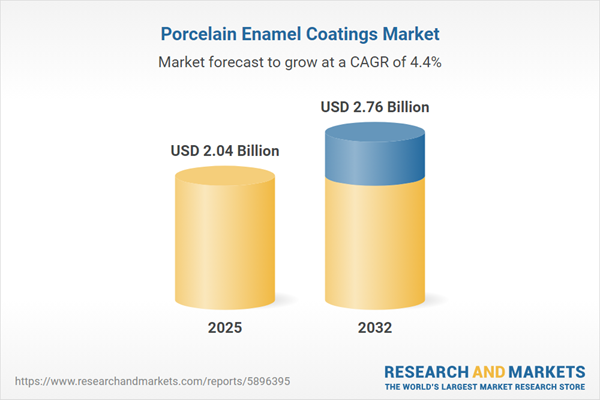Speak directly to the analyst to clarify any post sales queries you may have.
Senior decision-makers navigating industrial asset management are emphasizing robust, versatile strategies for equipment protection. Porcelain enamel coatings increasingly offer a reliable pathway to achieve operational resilience, compliance, and productivity across diverse production environments.
Market Snapshot: Porcelain Enamel Coatings Market
The global porcelain enamel coatings market is valued at USD 1.96 billion in 2024, with expectations to reach USD 2.04 billion by 2025 and a compound annual growth rate of 4.36%. By 2032, the sector is projected to grow to USD 2.76 billion.
Steady expansion is seen across appliance manufacturing, construction, and regulated industrial applications, as organizations elevate their standards for equipment durability and process reliability. Market dynamics are strongly influenced by the need to optimize asset lifecycles, enhance performance, and foster compliance with evolving regulatory frameworks. Innovations in porcelain enamel coating technologies continue to set benchmarks in sanitation, durability, and operational efficiency as end-users adapt to demanding industry requirements.Scope & Segmentation of the Porcelain Enamel Coatings Market
- End Use Industries: Appliances, construction, cookware, industrial machinery, laboratory equipment, medical devices, pipelines, oil and gas, storage tanks, and heat exchangers implement porcelain enamel coatings to improve cleanliness and function under rigorous conditions.
- Product Types: Acid-resistant, antibacterial, decorative, high-temperature, and multi-coat porcelain enamels address a broad spectrum of sector-specific requirements for maintenance, compliance, and hygiene.
- Application Techniques: Dipping, flow coating, roll application, as well as spray methods—using both air atomized and airless options—allow manufacturers to create uniform protective finishes for a range of volumes and substrates.
- Forms: Liquid and powder formulations offer companies flexibility for custom projects and large-scale, standardized manufacturing while supporting various application needs.
- Substrates: Compatibility extends to aluminum, cast iron, copper, and steel, enabling tailored protection that aligns with both material-specific and compliance-driven objectives.
- Distribution Channels: Direct sales, established dealer networks, strategic distributor partnerships, and alliances facilitate efficient market access and adaptive procurement.
- Regions Covered: The Americas, Europe, Middle East, Africa, and Asia-Pacific influence material preferences and solution customization, with regional regulations shaping adoption patterns and compliance strategies.
- Companies Profiled: Leading market participants such as Ferro Corporation, PPG Industries, The Sherwin-Williams Company, Akzo Nobel N.V., Nippon Paint Holdings Co., Kansai Paint Co., Jotun A/S, Axalta Coating Systems, Norglass S.A., and IIG Products Co. are recognized for their technical knowledge and international footprint.
Key Takeaways for Senior Decision-Makers
- Porcelain enamel coatings support asset longevity and help organizations maintain stringent hygiene and safety standards throughout core processes.
- Advanced antibacterial and multi-layer technologies deliver enhanced sanitation while promoting consistent, reliable performance across demanding operational cycles.
- Strong alignment between purchasers and coating suppliers builds supply chain flexibility, enabling proactive adaptation to regulatory and sustainability targets.
- Integration of digital monitoring and sensor technologies within coating infrastructure supports predictive maintenance, streamlined asset supervision, and resource optimization.
- Formulations emphasizing powder base and low-VOC characteristics assist in meeting environmental requirements and aligning with broader sustainability mandates.
Tariff Impact: Navigating U.S. Adjustments and Supply Chain Adaptations
Recent U.S. tariff adjustments are shaping procurement and sourcing strategies for sectors dependent on imported metals used in porcelain enamel coatings. Organizations are bolstering engagement with domestic suppliers and assessing vertical integration to minimize supply risk and disruption. These approaches reinforce compliance, promote supply stability, and help safeguard continuous operations amid regulatory changes.
Methodology & Data Sources
This analysis draws on primary discussions with industry professionals, a comprehensive review of industry literature, and detailed evaluation of financial and trade records. Insights from subject-matter experts underpin the practicality and relevance of all findings, enhancing strategic usability for executive resource planning.
Why This Report Matters
- Delivers actionable segmentation and executive-level insights for leaders in compliance-focused industries facing complex operational challenges.
- Provides guidance for technology selection and asset alignment to reinforce operational consistency and manage risk.
- Equips procurement and sourcing teams with updated viewpoints on regulatory trends and global supply chain shifts.
Conclusion
Porcelain enamel coatings are strengthening organizational resilience and compliance across key industries. Their expanding role is central to optimizing reliability, fulfilling regulatory objectives, and achieving sustained operational excellence.
Additional Product Information:
- Purchase of this report includes 1 year online access with quarterly updates.
- This report can be updated on request. Please contact our Customer Experience team using the Ask a Question widget on our website.
Table of Contents
3. Executive Summary
4. Market Overview
7. Cumulative Impact of Artificial Intelligence 2025
Companies Mentioned
The companies profiled in this Porcelain Enamel Coatings market report include:- Ferro Corporation
- PPG Industries, Inc.
- The Sherwin-Williams Company
- Akzo Nobel N.V.
- Nippon Paint Holdings Co., Ltd.
- Kansai Paint Co., Ltd.
- Jotun A/S
- Axalta Coating Systems Ltd.
- Norglass S.A.
- IIG Products Co., Inc.
Table Information
| Report Attribute | Details |
|---|---|
| No. of Pages | 194 |
| Published | November 2025 |
| Forecast Period | 2025 - 2032 |
| Estimated Market Value ( USD | $ 2.04 Billion |
| Forecasted Market Value ( USD | $ 2.76 Billion |
| Compound Annual Growth Rate | 4.3% |
| Regions Covered | Global |
| No. of Companies Mentioned | 11 |









